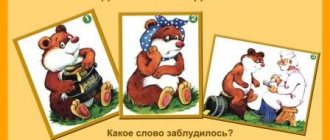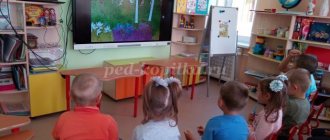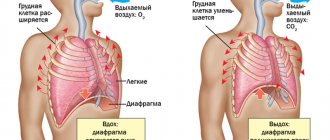Compiling stories based on plot pictures in the preparatory group
Alexandra Bocharova
Compiling stories based on plot pictures in the preparatory group
In classes in a preparatory group for school, a teacher’s model should be offered only if the children have poor ability to coherently present the content of a picture . In such classes, it is better to give a plan, suggest a possible plot and sequence of the story . In groups of senior preschool age, all types of stories based on a picture : a descriptive story based on subject and plot paintings , a narrative story , a descriptive story based on a landscape painting and still life .
You can widely use a story based on a series of pictures (for example, on the topic “Our site in winter and summer”
, where what is required is no longer a simple listing of ongoing events, but a consistent
story with a beginning , culmination and denouement. The conversation on issues that precedes the story concerns the main points, the key points of the depicted plot .
improve the ability to tell stories based on a series of pictures : compiling a collective story - the teacher begins the story , the children finish; One child starts, another continues.
In the preparatory group, children are first introduced to composing narrative stories . So, they come up with a beginning or an end to the plot depicted in the pictures : “That’s how it went for a ride!”
,
“Where did you go?”
,
“Gifts for Mom for March 8th”
,
“The Ball Flew Away”
,
“Cat with Kittens”
, etc. A clearly formulated task encourages you to creatively complete it.
It is very important to teach children not only to see what is depicted in the picture , but also to imagine previous and subsequent events. For example, based on these pictures, the teacher can ask the following questions: What did the guys say to the boy? ( "That's how I rode!"
);
How did the children prepare gifts for their mother? ( "March 8"
);
who put the basket here and what happened? ( "Cat with Kittens"
).
Several questions may be asked, as if outlining the plot line of the narrative story : where did these children come from? What happened to them next? How did these children continue to be friends? ( "Waiting for guests"
)
The same picture can be used several times during the year, but different tasks should be set, gradually making them more difficult. When children master free storytelling , you can offer them two or more paintings (already seen and even new ones)
and set a task - to come up with
a story based on any picture . This will give them the opportunity to choose the content that is most interesting to them, and for those who find it difficult, an already familiar plot , which is easy to use to compose a story .
Such activities develop independence and activity, and foster a sense of self-confidence. In the senior and preparatory groups, work continues to develop the ability to characterize the most significant things in a picture . The emphasis on what is essential comes out most clearly in the selection of the name of the painting , so children are given tasks like “What did the artist call this painting ?”
,
“Let’s come up with a name”
,
“What can we call this
picture ?” .
Along with highlighting and characterizing the most essential, one must learn to notice details, convey the background, landscape, , etc. d.
The teacher teaches children to introduce short descriptions of nature stories Of great importance in this case is such a methodological technique - analysis of the teacher’s story . Children are asked questions: “Where did I start my story ?”
,
“How is my
story different from Alyosha’s story ?” , “How did I
talk about the time of year depicted in the picture ?”
Gradually, older preschoolers learn to supplement their stories based on the picture with a description of the depicted landscape, , etc. d. Here, for example, is the beginning of Marina’s story (6 years old)
based on
the painting “That’s how I rode!”
: “This
picture depicts winter .
The day is sunny and cold. And the sky is all colorful. It’s because of the sun that it glows so much.” The introduction of such small descriptions a story based on a painting prepares children for composing stories based on landscape paintings and still lifes . This type of storytelling is used in the pre-school group .
Notes on the development of speech "Composing a story using pictures" (preparatory group) Notes on the development of speech (preparatory group) "Composing a story using pictures" Objectives: learn to compose a story based on.
Summary of educational activities for speech development “Composing stories based on subject and plot pictures” Purpose: to learn to compose stories based on subject and plot pictures using prepositions; answer questions about the content of the text you listened to;
Summary of educational activities on the formation of monologue speech “Telling the story of pictures “Visiting a fairy tale” Synopsis of the educational activity on the formation of monologue speech with preschool children Topic: telling the story of pictures “Visiting a fairy tale.”
Summary of the lesson “Composing stories about Dymkovo, Filimonov, Kargopol toys” in the middle group of HVZ Educational area: “Speech development”; fiction. Pedagogical goal: to teach children to write a descriptive story.
Summary of a lesson on speech development in the preparatory group “Writing descriptive stories about pets” OOD in the mixed-age group “Writing descriptive stories about pets” Objectives: • continue to introduce pets.
GCD for the development of speech of children of the preparatory group for school “Composing stories on the theme “Autumn has come” GCD for the development of speech of children of the preparatory group for school Topic: Composing stories on the theme “Autumn has come” Integration of educational.
Speech development in the older group. Compiling a story based on pictures “We bought a puppy” Speech development in the older group. Topic: “Compiling a plot story based on the pictures “We bought a puppy.” Goal: learn to write a descriptive story.
Compiling a story based on reference pictures on the topic “Winter” Summary of a speech therapy lesson on the formation of coherent speech in a preparatory group for children with ODD. Topic: Compiling a story using reference points.
Open subgroup lesson in the preparatory school group “Gloomy autumn is looking through the window.” Writing stories about autumn” Open subgroup lesson in a pre-school group. Topic: “Gloomy autumn looks out the window.” Writing stories about.
Source
Goals: — activation of the dictionary on the topic; - learn to compose a story based on a plot picture; - learn to form related words; - learn to form nouns from adjectives; - learn to extend sentences with adjectives; - develop articulatory, general and fine motor skills, breathing, thinking.Progress of the lesson
1. Organizational moment.
Game "4 extra":
4 pictures depicting the seasons are displayed on the easel, where winter turns out to be superfluous every time. Children identify the extra picture. The speech therapist notes that today we will talk about winter.
2. Introduction to the topic.
Speech therapist : - oh, children, look, we received a letter. (Shows the envelope. Children (if they can) read to whom the letter is addressed and where it came from. The letter came from Africa from a boy named Pochemuchka). Let's read: Hello guys! My name is Pochemuchka. I live in distant and hot Africa. I've heard a lot about the winter that happens in your country, but I just can't understand what it is. Please tell me about her. Your Doug Pochemuchka.
Speech therapist:
- Well, guys, shall we tell Pochemochka about winter? But for this we need to stretch our tongue so that it can tell everything beautifully.
Fairy tale: once upon a time there was a tongue (mouth open, tongue showing) in a big house. He got up early in the morning, stretched up, down, left, right and looked out the window (the tongue reaches out to the nose, to the chin, to the left cheek, to the right cheek). And it was snowing outside, the whole house was already covered with snow, the tongue went out into the street and began to clear the snow - from the door, from the roof (exercise “Painter”, “Delicious Jam”). I cleaned it and returned home along the steps (we first hug the lips with a wide tongue, then the teeth). He drank a cup of tea at home (exercise “Cup”), ate a bagel and went to rest (exercise “Punish the naughty tongue”).
3. Conversation about winter.
Speech therapist: - Well, our tongue is also ready to talk about winter. - Guys, what is winter? - How many months does winter have? — What month does winter begin? And what month ends? Which one is in the middle? — Name the signs of winter. — What is the weather like in winter? — How do animals live in winter? - And the birds? — How can we help the birds? - Why do we love winter?
4. Playing with the ball.
Speech therapist: -Children, let's play and tell Pochemuchka that if it snows during the day, then it is called snowy. The speech therapist throws the ball to the children one by one and asks questions, the children answer and return the ball. If it's frosty - if it snows in December - If it's windy - in January - If it's cold - in February - If it's sunny - if it's raining -
5. Words-relatives.
Speech therapist: - We have related words in the Russian language. Let's tell you why, what relative words does winter have, and what does snow have?
6. Passing the ball.
Speech therapist: - What is winter like? Let's tell Whychka and the magic ball will help us with this. You take the ball, say one word, what kind of winter it might be, and pass it to another child. For example, winter is snowy, fluffy, etc. - What kind of snow? — What do people do in winter? - And the birds?
7. Physical exercise.
Come on, my friend, be brave, my friend, roll your snowball through the snow. (children walk in a circle, one after another, pretending to roll a snowball in front of them) It will turn into a thick lump, (they stop, “draw” a lump with both hands) And the lump will become a snowman. (“draw” a snowman from three circles of different sizes) His smile is so bright! (show a smile on their face with their hands) Two eyes, a hat, a nose, a broom. (show their eyes, cover their head with their palm, show their nose, stand up straight, hold an imaginary broom) But the sun will get a little hot - (slowly crouch) Alas! - and there is no snowman. (shrugs shoulders, shrugs)
8.Picture.
The speech therapist puts up a picture and says: “Guys, using this picture we will tell Whychka about winter.” And small pictures will help us - they will give us hints. Listen carefully. The speech therapist gives a sample story while simultaneously displaying subject pictures.
A cold, frosty winter has arrived. The first white fluffy snow fell. The trees were bare, but now they are covered with snow, like a blanket. People dress warmer - boys and girls wear fur coats, hats, scarves, boots, and mittens. The birds are very cold and hungry - after all, the food is under the snow, but the children made a feeder and poured grains into them and now tits and bullfinches are pecking at the grains. There is a lot of entertainment in winter. Boys are skating on a frozen pond. And one of them fell - probably he still doesn’t know how to ride well. Other children are sledding and making a snowman. Children have a lot of fun in winter! (for those words that are underlined, noticeable pictures are displayed)
9. Independent storytelling based on pictures.
Speech therapist: - Katya, now tell me about winter. Small pictures will help you. Don’t forget that Pochemuchka knows nothing about winter and he always needs to be told what kind of winter it is, what kind of snow... (2 children make up stories)
10. Game “Snowflakes and the Breeze” Children are divided into two teams “snowflakes” and “breeze”. Snowflakes are spinning, running on their toes; The “breeze” is resting at this time. After the words “the wind has woken up,” the children exhale and say “sh-sh-sh” and the snowflakes hide from the wind and settle. The game continues 4-5 times; after which the children in the teams change roles.
11. Independent storytelling without relying on pictures.
Speech therapist: - Kolya, we are already adult children and you will try to talk about winter without pictures to help. (2 people make up stories)
12. Finger game. One, two, three, four, five, (bend fingers one at a time) We came to the yard for a walk. (“they walk” along the table with their index and middle fingers) They sculpted a snow woman, (“they sculpt” a lump with two palms) They fed the birds crumbs, (“they crumbled bread” with all their fingers) Then we rode down the hill, (they run the index finger of the right hand along the palm of the left hands) And they were also lying in the snow. (put their palms on the table, first one side, then the other) Everyone came home covered in snow. (dusts off palms) We ate the soup and went to bed. (movements with an imaginary spoon; hands under the cheek)
13. What did the artist mix up? A tall tale.
Speech therapist: - And Pochemuchka also sent us a picture. It was painted by their African artist. See if he drew everything correctly? (children name the artist’s mistakes)
14. Summary of the lesson.
Speech therapist: - So we told Pochemuchka about winter. And now I propose to choose the best story - the one that we will write in a letter to Pochemuchka. Give this snowflake to the child whose story you think is the best.




